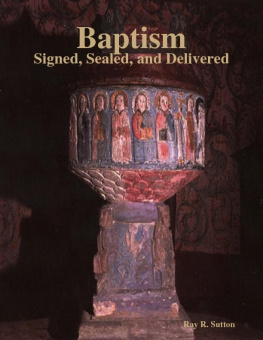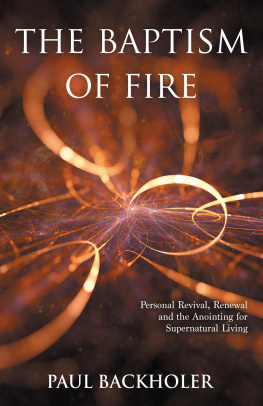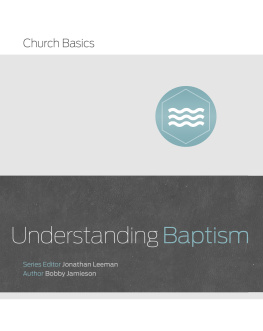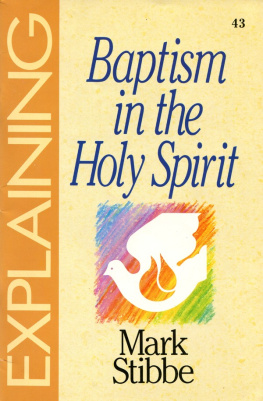Ray R. Sutton - Signed, sealed, and delivered: A Study of Holy Baptism
Here you can read online Ray R. Sutton - Signed, sealed, and delivered: A Study of Holy Baptism full text of the book (entire story) in english for free. Download pdf and epub, get meaning, cover and reviews about this ebook. year: 2001, publisher: Classical Anglican Press, genre: Religion. Description of the work, (preface) as well as reviews are available. Best literature library LitArk.com created for fans of good reading and offers a wide selection of genres:
Romance novel
Science fiction
Adventure
Detective
Science
History
Home and family
Prose
Art
Politics
Computer
Non-fiction
Religion
Business
Children
Humor
Choose a favorite category and find really read worthwhile books. Enjoy immersion in the world of imagination, feel the emotions of the characters or learn something new for yourself, make an fascinating discovery.
- Book:Signed, sealed, and delivered: A Study of Holy Baptism
- Author:
- Publisher:Classical Anglican Press
- Genre:
- Year:2001
- Rating:4 / 5
- Favourites:Add to favourites
- Your mark:
- 80
- 1
- 2
- 3
- 4
- 5
Signed, sealed, and delivered: A Study of Holy Baptism: summary, description and annotation
We offer to read an annotation, description, summary or preface (depends on what the author of the book "Signed, sealed, and delivered: A Study of Holy Baptism" wrote himself). If you haven't found the necessary information about the book — write in the comments, we will try to find it.
Signed, sealed, and delivered: A Study of Holy Baptism — read online for free the complete book (whole text) full work
Below is the text of the book, divided by pages. System saving the place of the last page read, allows you to conveniently read the book "Signed, sealed, and delivered: A Study of Holy Baptism" online for free, without having to search again every time where you left off. Put a bookmark, and you can go to the page where you finished reading at any time.
Font size:
Interval:
Bookmark:
The Great Commission commands Baptism into the Third member of the Godhead: baptizing into the name of the Father, and of the Son, and, Baptism into the Spirit. The meaning of Baptism into the Spirit is indicated in St. Peter s sermon at Pentecost, in which he concludes a baptismal call, Repent and be baptized in the name of Jesus Christ for the remission of sins, and you shall receive the gift of the Holy Spirit (Acts 2:38). Peter does not say, may ; he clearly uses a future tense verb without any implication of a subjunctive mood, which is normally used if may is intended. He informs the new converts that they will receive the gift of the Holy Spirit when baptized, water baptized . The work of the Holy Spirit is connected to the Sacrament, not separated from it. Jesus had told His disciples, John truly baptized with water, but you shall be baptized with the Holy Spirit not many days from now (Acts 1:5). But when those days arrived, that is Pentecost, Peter tied the Pentecostal to the Sacramental. He promised the gift of the Holy Spirit in Baptism. Granted, the Holy Spirit was not somehow physically contained in the water, as we indicated in earlier discussions about the nature of a Sacrament. Nevertheless, God conveys grace in terms of the Sacrament, using baptismal language that describes a union formed with each member of the Godhead.
Jesus contrasts His Baptism with the baptizing of John. It was not water vs. Spirit, as though the Spirit would work apart from Baptism. Rather, the contrast was between water Baptism without the Holy Spirit (John the Baptist s Old Covenant ritual cleansing) and Trinitarian water Baptism involving the work of the Spirit. Sounds remarkably familiar to what Jesus told Nicodemus: Unless one is born of water and the Spirit, he cannot enter the kingdom of God (John 3:5). The True Rabbi noted to Nicodemus what He again reminded His disciples before Pentecost, which Peter obediently applied after his Pentecost sermon. Jesus Spirit Baptism was the Baptism of water and the Spirit, that is, Trinitarian Baptism into the Father, the Son, and the Holy Spirit. Unless a person wants to deny the Great Commission of Jesus, there is no escaping the fact that water Baptism is in some sense Baptism into the Holy Spirit. The question is: In what sense?
Some of course have simply denied any connection between the Spirit and water Baptism. Jesus baptismal formula is nominal, meaning in name only. One receives the Name of the Father, and of the Son and of the Holy Spirit at Baptism, but not the reality. If this is true, was Jesus really commanding His disciples to go out and make disciples by baptizing in name only with no reality attached to the Name of God? Was Jesus directing His disciples to create nominal Christians, a type of Christianity in name only? Was this the kind of baptismal practice that changed the world? A negative answer should be given to these questions is apparent. Baptism into the name of God, especially God the Holy Spirit, is not Baptism in name only. St. Paul speaks of the work of the Holy Spirit with reference to Baptism when he beckons the Hebrews, Let us draw near with a true heart in full assurance of faith, having our hearts sprinkled from an evil conscience and our bodies washed with pure water (Hebrews 10:22). The outward and visible sign is the body washed with pure water, and the inward and spiritual grace is a heart sprinkled from an evil conscience. This language indicates more than a nominal interpretation of Jesus commission to baptize into the name of the Holy Spirit.
Of course some scholars do not agree that St. Paul wrote the Epistle to the Hebrews . Apollos or Barnaba s are two suggestions. However, the historic Church has agreed for the most part that it was St. Paul.
Fourth, the Apostle Paul indicates that baptismal union with Christ leads to communion with Him by way of presenting oneself to God as a living sacrifice. As he speaks of Baptism as incorporation, communion is explained as real participation in Christ (1 Corinthians 10:16). It is union and communion by means of the two Sacraments. It is at the Holy Communion that a reckoning occurs through presentation of oneself as a living sacrifice.
Likewise you also, reckon yourselves to be dead indeed to sin, but alive to God in Christ Jesus our Lord. Therefore do not let sin reign in your mortal body, that you should obey it in its lusts. And do not present your members as instruments of unrighteousness to sin, but present yourselves to God as being alive from the dead, and your members as instruments of righteousness to God (Romans 6:12-13).
Later in the Epistle, the Apostle gives us some sense of how and where this reckoning and presentation would occur, when he again appeals to the concept of presenting the person to God. He uses very precise liturgical language, I beseech you therefore, brethren, by the mercies of God, that you present your bodies a living sacrifice, holy, acceptable to God, which is your reasonable service (Romans 12:1). The words reasonable service translate a Greek phrase that implies some kind of liturgical action. They are literally translated, which is your rational
[or reasonable/logical, by extension, well-considered ] act of public worship/liturgical worship. Carefully considered, it is not hard to see why the Church has tied this action to the Eucharist, Holy Communion.
Putting the above passages together, the Apostle calls his people to present their bodies as a living sacrifice through the once for all sacrifice of Christ s death into which they were baptized. The once for all sacrifice of Christ on the Cross is celebrated at Holy Communion. This is where the Church s sacrifice should be offered. Apart from Christ all sacrifice is worthless. In the 1662
Book of Common Prayer , heed the language of one of the classic post-communion prayers (pre communion in the 1928 BCP).
And we earnestly desire thy fatherly goodness, mercifully to accept this our sacrifice of praise and thanksgiving; most humbly beseeching thee to grant that, by the merits and death of thy Son Jesus Christ, and through faith in his blood, we, and all thy whole Church, may obtain remission of our sins, and all other benefits of his passion. And here we offer and present unto thee, O Lord, our selves, our souls and bodies, to be a reasonable, holy, and living sacrifice unto thee; humbly beseeching thee, that we, and all others who shall be partakers of this Holy Communion, may worthily receive the most precious Body and Blood of thy Son Jesus Christ, be filled with thy grace and heavenly benediction, and made one body with him, that he may dwell in us, and we in him. And although we are unworthy, through our manifold sins, to offer unto thee any sacrifice; yet we beseech thee to accept this our bounden duty and service; not weighing our merits, but pardoning our offences, through Jesus Christ our Lord; by whom, in the unity of the Holy Ghost, all honor and glory be unto thee, O Father Almighty, world without end. Amen.
The parallel between this prayer and its theology and the passages of Paul in Romans 6 and 12 is unmistakable. Therefore, the Church has understood this presentation through Christ as the best way to avoid any notion of a human being able to earn his way to God by his own efforts, what is called Pelagianism in the Articles of Religion (Article 9). It is by viewing the presentation as being preeminently accomplished through the Eucharistic celebration of the once for all sacrifice of Christ. Union with Christ in Holy Baptism is fed through communion at the Holy Eucharist.
Then there is a very real practical problem. Children of believers normally begin to express faith the moment they become cognizant. Ask a little child of a believer if he or she loves Jesus. Or, probe as to his or her interest in Bible stories. Little ones have no guile. They are transparently honest if they do not understand. They will ask the most astute, deep, probing theological questions. They will and can believe as deeply as any adult. Should the Church be distrustful or skeptical about a child s faith? If so, would not this cynicism tend to undermine the very faith that Jesus lifts up as a model? It seems that it would. Therefore the practical reality, as well as the theological difficulty, demonstrates how a Zwinglian approach can overturn Jesus model.
Font size:
Interval:
Bookmark:
Similar books «Signed, sealed, and delivered: A Study of Holy Baptism»
Look at similar books to Signed, sealed, and delivered: A Study of Holy Baptism. We have selected literature similar in name and meaning in the hope of providing readers with more options to find new, interesting, not yet read works.
Discussion, reviews of the book Signed, sealed, and delivered: A Study of Holy Baptism and just readers' own opinions. Leave your comments, write what you think about the work, its meaning or the main characters. Specify what exactly you liked and what you didn't like, and why you think so.












